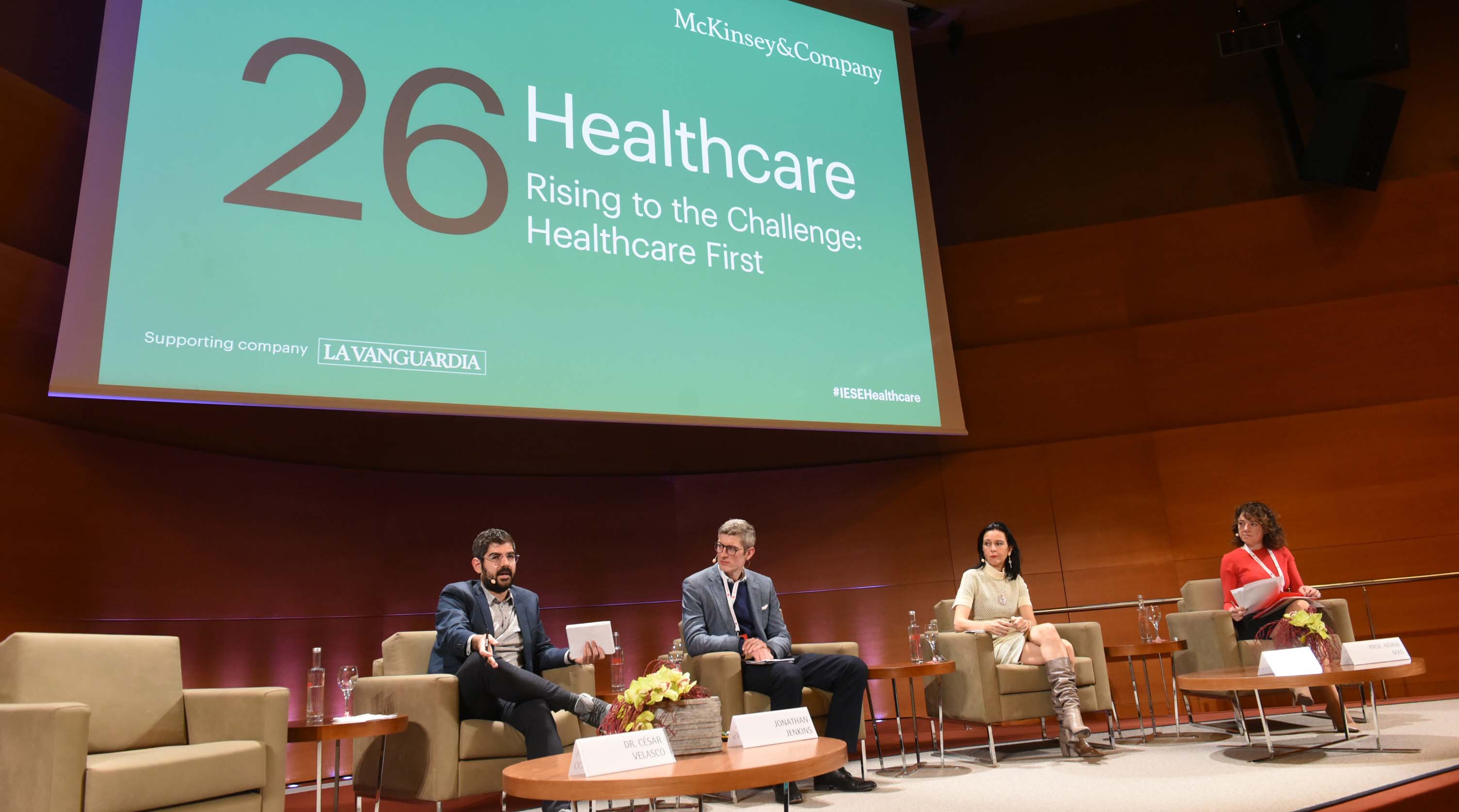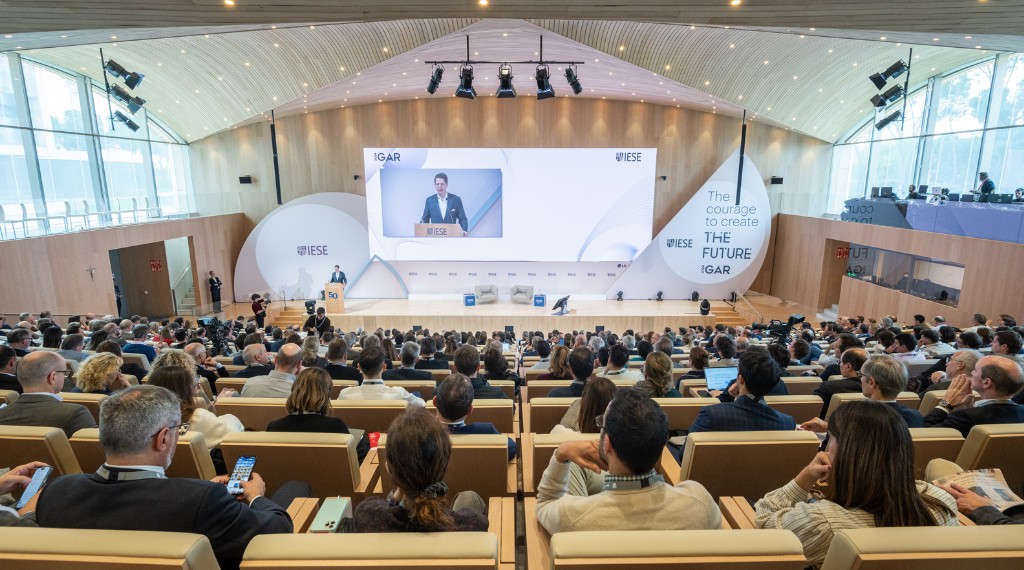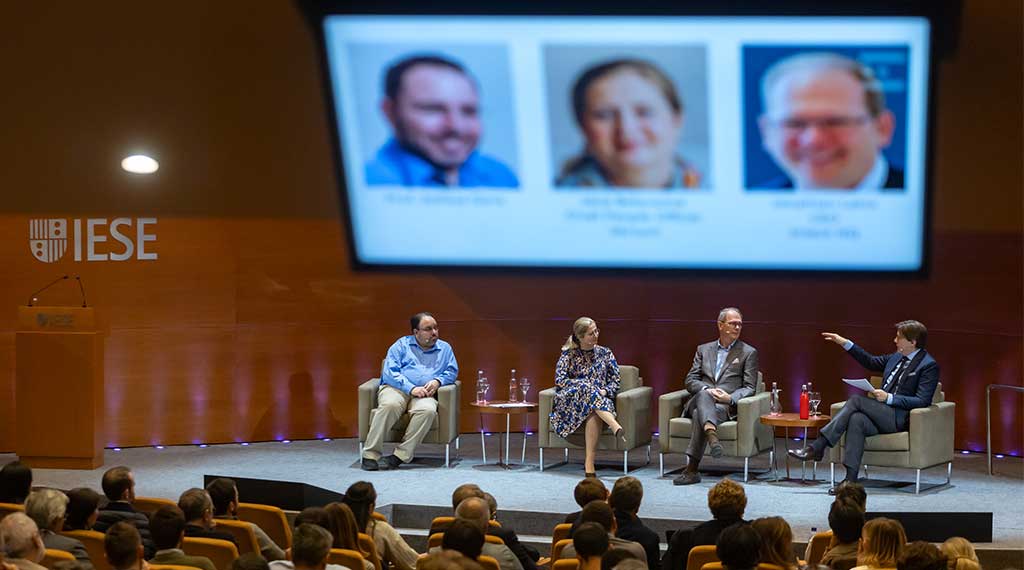Stories
Will big data make us healthier ?
26 Healthcare industry meeting examines artificial intelligence, big data, sustainability and more
Prof. Nuria Mas (r) moderates a panel on technology and big data in healthcare.
Photo: Jordi Estruch
November 22, 2019

What do we want from our healthcare system? And how can technologies such as big data and artificial intelligence, with their large potential and even larger ethical dilemmas, help us get there?
These were some of the themes of 26 Healthcare, the annual industry meeting held this week on the Barcelona campus. Organized by IESE in collaboration with McKinsey, the title of this year’s meeting was Rising to the Challenge: Healthcare First; Professor Núria Mas was academic director of the event. Sessions covered everything from technology-driven change to sustainability to the patient of the future.
“We must define the system we want first – the vision. This will impact the data,” said César Velasco, director of the Agency for Healthcare Quality and Assessment of Catalonia (AQuAS). Acting the other way around – and letting the data define the system – was a mistake, Velasco said. “We need more meetings about vision and fewer about business models.”
He said the biggest questions at stake were: “How do we envision the system?” and “What is its value for the public?”
Big data and its moral dilemmas
Technology-related issues – particularly big data and artificial intelligence – were recurrent topics of discussion. AI is believed to have huge potential applications in healthcare for diagnosing illness, for pinpointing treatment, for predicting health risks.
But it relies on troves of data that humans provide, which raises a host of ethical questions, such as how people’s data is handled, and how we can know whether algorithms are using our data unethically.
Michal Rosen-Zvi, director of health informatics at IBM Research, speaking of precision medicine, said, “AI can offer the right drug to the right person at the right time. But to achieve this, we need access to data.”
Part of the solution lies in better stewardship of our data. “Are we clear what a company wants to do with [it]?” asked Elena Bonfiglioli, regional business leader health and life sciences (EMEA) at Microsoft, hinting that people don’t let their data be captured precisely because they are not.
Jonathan Jenkins, senior principal at QuantumBlack, remarked how solutions to the algorithm issue will be uncovered as “explainable AI” develops – an exciting new area that tells us why an algorithm is telling us what it’s saying.
Jenkins insisted that merely “concluding [the moral dilemma] is complicated and therefore not tackling it is akin to a team of paramedics not crossing the road to get to a patient.” After all, the advantages of data usage are exponential, as epitomized by the UK’s “Data Saves Lives” campaign.
Whose data is it anyway?
The moral arguments cannot gain traction without asking: Who owns the data? Is it the citizen, the public system, or the government? The answer depends on the country, or region. In Europe, for instance, the citizen is in control.
The European model presents its own challenges, though, because citizens have to give their permission at each and every turn. Jenkins cited an example of how fitting watches with a special mechanism was a very effective way of capturing the data on when people smoke, but that it cannot be done without the user ticking a box.
“Given the fact that self-reporting is very weak,” he said, “we need to be able to make better use of the data available to us. Part of this involves linking across lifestyle and getting longitudinal views.”
In Europe at least, then, the data is there but the owner has it.
Velasco assured, “We definitely don’t need to encourage more data in the system.” He ruled out overriding citizen rights and mimicking the U.S. model. “[To do so] would be to make EMR (Electronic Medical Records) the ultimate data warehouse. We don’t have that vision.”
For Bonfiglioli, “Our future vision is not one data owner, nor even a few data owners. Data is an amazing equalizer with the right governance. But we need distributed ownership and clarity of purpose.”
Getting the public system involved in data collection would be a recipe for disaster, said Velasco. “Once you add data to your tasks you become responsible for the use of it. The public system has other civil responsibilities.”
Jenkins said Europe had been at the forefront of how data should be used, and that he suspected it would lead this on healthcare too.
Short- vs long-term vision
Jenkins urged discussions on what the short- and long-term opportunities of AI are.
The key here, he said, is to be visionary, but to also be practical. “Opportunities now (e.g. working on efficiency using talent and technology) need to be balanced with steps to build organizations’ abilities to move toward a more visionary future.”
Velasco added: “In the short term, we overestimate AI just as we tend to all tech innovations. But in the long term, we underestimate them.”


